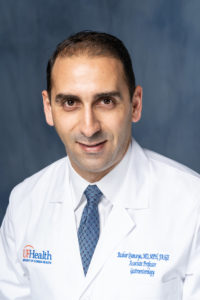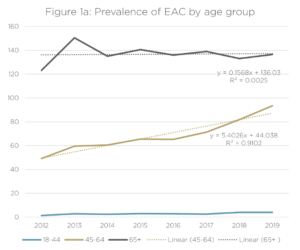
Overall incidence of esophageal cancer and Barrett’s esophagus may have plateaued in recent years, but new data show significant increases among the 45-to-64-year-old population, according to a study being presented at Digestive Disease Week® (DDW) 2022.
“This finding supports the need for more vigilance and additional research to confirm such trends,” said Dr. Bashar Qumseya, lead researcher of the study and associate professor of medicine and chief of endoscopy at the University of Florida, Gainesville. “If you’re a provider and have patients with multiple risk factors, even though they might be in their 40s and 50s, think about these conditions, discuss the risks with your patients, and consider a screening endoscopy.”
Dr. Qumseya and his team analyzed the prevalence of esophageal cancer and Barrett’s esophagus from 2012 to 2019 among more than five million individuals using electronic health record data in the OneFlorida Clinical Data Research Network. To assess age-related trends, they divided individuals into three age-based groups — young (18 to 44 years of age), middle-aged (45 to 64 years of age), and elderly (≥65 years of age). Researchers found that over the eight-year timeframe of the study:
- The prevalence of both esophageal cancer and Barrett’s esophagus increased logarithmically in the middle-aged group: nearly doubling, from 49 to 94 per 100,000 for esophageal cancer, and increasing 50%, from 304 to 466 per 100,000 for Barrett’s esophagus.
- The prevalence of esophageal cancer in the elderly group remained stable.
- The rate of increase for Barrett’s esophagus was highest among those 51 to 60 years of age.
They also looked at the rate of esophagogastroduodenoscopy (EGD) during this timeframe and found no increase that might explain the prevalence data. “Sometimes if you are doing more screening, it can look like the prevalence of the condition is increasing; however, that is not what we’re seeing here,” said Dr. Qumseya. “Most people with risk factors are not getting endoscopies.”
The prevalence of the two diseases in the middle-aged group is still lower than among the elderly, but Dr. Qumseya warned that if current trends increase, their risk of cancer could reach that of the elderly.
These data add important context to identifying who is at highest risk for the diseases and could ultimately be used to inform screening practices. Dr. Qumseya stressed that clinicians should not consider esophageal cancer and Barrett’s esophagus as diseases of the elderly but should look at a patient’s entire risk profile.
Dr. Qumseya will present data from the study, “Alarming increase in prevalence of esophageal cancer and Barrett’s esophagus in middle-aged patients: findings from a statewide database of over five million patients,” abstract 671 on Monday, May 23, at 10:10 a.m. PDT.




